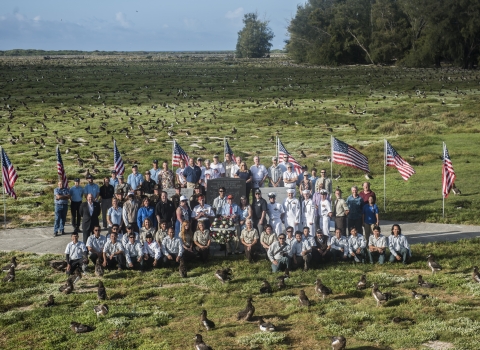As most people are aware, populations of many species of grassland-associated butterflies, moths, and bumblebees in the Great Plains of North America are experiencing steep declines due to habitat loss and degradation. These declines are exacerbated by the generally limited dispersal ability of insects, which make local populations susceptible to extirpation following habitat fragmentation. What is less clear, though, is what to do about these declines. Habitat restoration—such as pollinator gardens and conservation plantings—is an obvious solution, but guidance is lacking on how to put restoration efforts on the ground in the most effective and efficient manner.
In response to multiple requests for guidance on pollinator conservation efforts, the U.S. Fish and Wildlife Service’s Habitat and Population Evaluation Team (HAPET) developed a spatial model to guide conservation efforts for pollinators in the Great Plains. Given limited understanding of specific pollinator biology and population status, HAPET used pollinator biology along with principles of landscape ecology and metapopulation dynamics to develop a mechanistic model and decision matrix based on patch size and inter-patch distances to guide landscape-scale conservation efforts for pollinators (Figure 1). The model uses landscape-scale relationships at multiple patch size and distance thresholds to identify general conservation treatments for grassland patches that are large and near, large and isolated, small and near, and small and isolated. The model is also hierarchical in that it explicitly considers a suite of 12 local habitat treatments that can be applied under the umbrella of landscape-level conservation planning (Figure 2).
When applied to spatial landcover data depicting potential pollinator habitat, the matrix uses landscape characteristics to guide placement of conservation treatments to help ensure persistence of target pollinator populations. Patch size and connectivity thresholds can be set to match characteristics of target species, but in all cases, local management will be necessary to ensure that fine-grained features such as nectar sources and host plants are present (Figure 2). The model also demonstrated that non-native planted cover such as alfalfa and certain grasslands enrolled in the Conservation Reserve Program can substantially enhance landscape structure structure
Something temporarily or permanently constructed, built, or placed; and constructed of natural or manufactured parts including, but not limited to, a building, shed, cabin, porch, bridge, walkway, stair steps, sign, landing, platform, dock, rack, fence, telecommunication device, antennae, fish cleaning table, satellite dish/mount, or well head.
Learn more about structure by increasing grassland patch size and core area while decreasing distance between patches. Pollinators dependent on native prairie will also benefit from planted cover that provides nectar sources and serves as a buffer from pesticides associated with croplands. Consistent with the principles of strategic habitat conservation, targeted monitoring and research will be necessary to validate and adapt the model to meet local conditions. The model, Published in Ecosphere, successfully identified patches of critical habitat for listed species and best locations for increasing and connecting habitat (Figure 3). Originally developed for nine state in the upper Midwest, the model has been expanded to include the 48 contiguous U.S states (Figure 3).
Figure 1. Principles of landscape ecology and metapopulation dynamics that influence many species of pollinators enabled HAPET to develop a simple decision matrix based on patch size and inter-patch distances that provides insight for guiding landscape-scale grassland conservation efforts. Populations of many pollinator species are influenced by patch size and isolation, which provides a framework for assessing pollinator populations relative to landscape characteristics (upper). This framework directly leads to a matrix of potential management treatments (lower) that can be implemented for conservation.
Figure 2. The HAPET pollinator model leverages the hierarchical nature of habitat selection to increase the benefits of landscape-level conservation planning and local delivery.
Figure 3. The patch size/isolation decision-support matrix provides landscape context for targeted conservation treatments; in this example from southwestern Minnesota, black polygons indicate critical habitat for Dakota Skipper, and options for improving connectivity between parcels of critical habitat are apparent. The patch size and distance thresholds used in this example are 100 ha and 1 km; size and distance thresholds can be selected to fit ecology and management of priority species. The model has since been applied across the lower 48 states and is available from the HAPET office.
HAPET Publications:
LeBrun, J.J., N.D. Niemuth, & R.D. Pritchert. 2021. Assessing pollinator populations across North Dakota. Final report prepared for the Natural Resources Conservation Service Reimbursable Fund Agreement IAA 67-6633-16-509: Pollinators.







